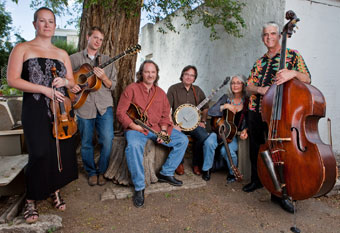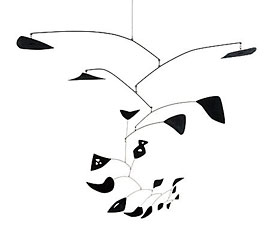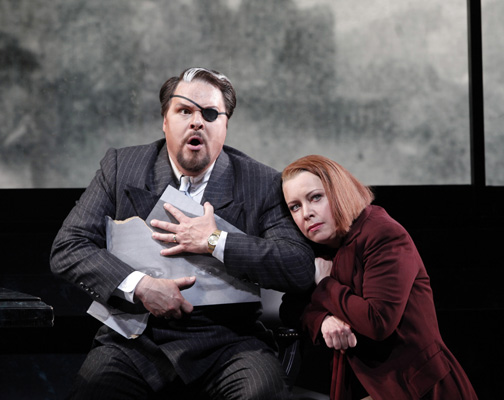 Experiencing the music of the progressive bluegrass outfit Hard Road is the equivalent of reading the poetry of Spike Milligan. Warm-hearted, yet with a mad professorly edge, the group tantalizes the eardrums with its homespun-streetwise blend of fast-strummed neo spirituals and folk songs.
Experiencing the music of the progressive bluegrass outfit Hard Road is the equivalent of reading the poetry of Spike Milligan. Warm-hearted, yet with a mad professorly edge, the group tantalizes the eardrums with its homespun-streetwise blend of fast-strummed neo spirituals and folk songs.
Headed up by mandolin player and songwriter Steve Smith and the guitarist and singer-songwriter Chris Sanders, the ensemble was performing at the Freight & Salvage Coffee House in Berkeley last night.
The atmosphere in the auditorium (which I always find to be way too sterile for roots music) was friendly and relaxed. The crowd was enthusiastic, even though the place wasn’t very full.
My only complaint: Smith and Sanders were joined on the stage by Bill Evans on the five-string banjo, bassist Bill Amatneek, and fiddler Megan Lynch. But while Evans’ banjo-playing was featured quite prominently on the program, Lynch and Amatneek didn’t get as much exposure. I would have liked to have heard more of these tremendously talented players.
In other news: I’m excited about the west coast premiere screening next Wednesday at the Kabuki Theatre of a new documentary film by Michael Lawrence all about the music of J. S. Bach. More information about the movie, which includes personal reflections on the great man’s sound by the likes of Joshua Bell, Bobby McFerrin, Philip Glass, Béla Fleck, Chris Thile, Hilary Hahn, Zuill Bailey, Matt Haimovitz and Edgar Meyer, can be found here.

 A trip to Los Angeles on LA Times business and a friend visiting from London has kept me away from my blog for the last few days.
A trip to Los Angeles on LA Times business and a friend visiting from London has kept me away from my blog for the last few days. Since launching a non-profit arts project at the start of this year, I’ve been thinking about fundraisers quite a bit. I’ve attended a few for other organizations and I even mounted a modest one myself for my project last October in advance of the launch.
Since launching a non-profit arts project at the start of this year, I’ve been thinking about fundraisers quite a bit. I’ve attended a few for other organizations and I even mounted a modest one myself for my project last October in advance of the launch.
 The upcoming TechnoCRAFT exhibition at the
The upcoming TechnoCRAFT exhibition at the  Yesterday, as we were standing in the vestibule/store at the
Yesterday, as we were standing in the vestibule/store at the  It’s hard to get the right balance with community music-making. As an oboist, I’ve played in groups which take themselves far too seriously and others which don’t take themselves seriously enough.
It’s hard to get the right balance with community music-making. As an oboist, I’ve played in groups which take themselves far too seriously and others which don’t take themselves seriously enough. Jan Kounen’s mostly insipid, exposition-laden feature film about the relationship between the 20th century’s greatest couturier and composer, Coco Chanel & Igor Stravinsky, is worth seeing for two reasons:
Jan Kounen’s mostly insipid, exposition-laden feature film about the relationship between the 20th century’s greatest couturier and composer, Coco Chanel & Igor Stravinsky, is worth seeing for two reasons: Yesterday, the
Yesterday, the  Is it better for a grant-making organization to dole out funds to arts organizations as a result of a closed-door decision-making process in which a panel of “experts” decides which organizations are most worth supporting or to let the public decide by leveraging the power of a popular social networking tool?
Is it better for a grant-making organization to dole out funds to arts organizations as a result of a closed-door decision-making process in which a panel of “experts” decides which organizations are most worth supporting or to let the public decide by leveraging the power of a popular social networking tool? The
The  After the snoozefest that was Faust, the
After the snoozefest that was Faust, the  The
The